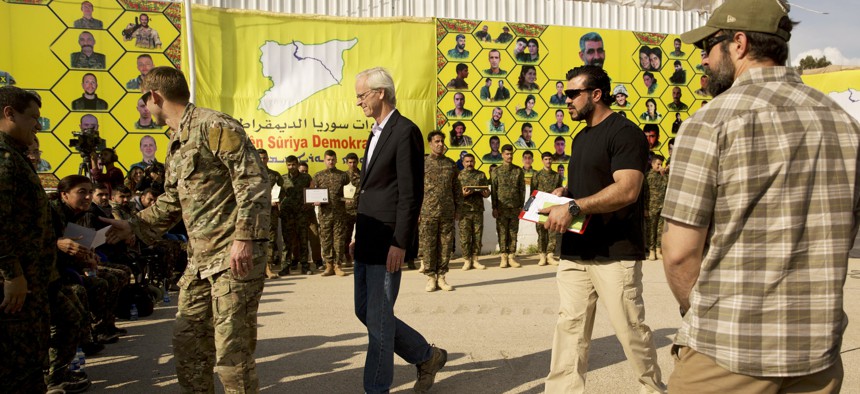
U.S. envoy William Roebuck, center, leaves the podium after speaking at a ceremony to celebrate U.S.-backed Syrian Democratic Forces (SDF) defeat of Islamic State militants in Baghouz, at al-Omar Oil Field base, Syria, Saturday, March 23, 2019. AP Photo/Maya Alleruzzo
Exclusive: Longtime US Diplomat Weighs America’s Legacy in Syria
The immediate damage of the Turkish invasion has been repaired, Bill Roebuck says, but warns ISIS could reemerge without more U.S. assistance.
When the explosions started, Ambassador Bill Roebuck recalls, it wasn’t at all clear who was causing them. It was Oct. 15, 2019, and Turkish-backed militias were advancing on a makeshift military base in Syria, a former cement factory about 40 miles from Kobani. President Donald Trump had effectively cleared the path for the invasion into territory previously controlled by the United States and its Kurdish partners.
“There was shooting going on, and our guys weren’t quite sure what was going on,” Roebuck recalled. “At first, we thought we were under attack.”
It turned out that the U.S.-backed Syrian Democratic Forces were setting fire to their armory and destroying other equipment to prevent Turkish-backed forces from seizing any of it if the base were to be overrun. But the detonations ended up setting large parts of the compound on fire, and that night, Roebuck — the last diplomat remaining — was evacuated alongside the remaining U.S. special forces and contractors still on base.
The abandonment of the Lafarge cement factory quickly became a synecdoche for the abrupt and chaotic American withdrawal from huge swaths of northeastern Syria. The next day, two U.S. Air Force F-15 jets destroyed a storage bunker at Lafarge to prevent munitions and other equipment from falling into the hands of armed groups. Critics say the withdrawal permanently damaged the United States’ ability to work with foreign partners and unnecessarily ceded influence in a strategically important corner of the globe.
For Roebuck, who until his retirement this fall served as the deputy special envoy to defeat ISIS, the ultimate legacy of the withdrawal is mixed.
A mild-mannered former English teacher, Roebuck has spent more time on the ground in Syria working in close contact with America’s Kurdish partners than perhaps any other U.S. diplomat. Mick Mulroy, a former CIA and Pentagon official, called him “one of the best expeditionary war zone diplomats I have seen in my career.”
In an exclusive exit interview with Defense One, Roebuck said the damage to the relationship with the SDF has been repaired — in large part because Trump ultimately agreed to keep a military presence in Syria. And he touts the important gains made in the fight against ISIS, nominally the reason the United States was in Syria to begin with.
“But we did lose significant leverage” amid the Turkish incursion into Syria, Roebuck said. “If you view our presence in northeast Syria as a source of leverage for some sort of future political solution [in the ongoing civil war in Syria], we pretty much overnight lost half of the territory that we were controlling, along with the SDF.”
The United States also likely lost some prestige on the global stage for not standing by its partner, the SDF, in the face of the Turkish advance, Roebuck said. But he cautioned that “I'm not sure how long term that is.” Countries, he said, “pursue their interests. Beneath the niceties, countries are pretty cold and calculating about how they do that.” In this case, he said, the complex relationship with Turkey, a NATO ally, could not be ignored as Washington was weighing how to handle the impending invasion.
Many of the more intractable problems in the Syria portfolio remain stubbornly unresolved — like the final disposition of thousands of ISIS fighters and families held in a variety of different camps run by the SDF in northeastern Syria — and Roebuck warns that if the United States doesn’t reinvest in stabilization assistance, ISIS may reemerge. Trump in 2018 froze stabilization assistance to Syria, and while some money that had already been appropriated was able to be used to help restore essential services destroyed in the fight against ISIS in Raqqa and Deir Ez-zor provinces, huge amounts of damage remains.
“The whole farming economy is what everything runs on, and all of the water canals, irrigation, water pumps, the grain silos — all of it was very heavily damaged during the occupation and particularly in the military effort to get ISIS out and defeat them,” Roebuck said. “A lot of it was very heavily damaged and remains pretty damaged.” Raqqa, he said, “looked like Dresden after World War II” in 2018, with entire city blocks flattened and the infrastructure totally gutted.
The U.S. failure to help rebuild in a more significant way “feeds a sense of resentment among residents in Syria that the coalition, led by the United States, came in and did all this destruction in order to defeat ISIS. And then just left and didn't help the people in a significant way,” Roebuck said. “We did a lot, but given the scale of destruction, their view is that we didn't help them rebuild.”
That, in turn, may provide an opening for ISIS to leverage that sense of aggrievement for its own recruitment purposes, Roebuck said.
“I think that the threat is if you don't help them rebuild, all that resentment and sense of grievance has nowhere else to go,” Roebuck said. “And some of it is going to drift back to some of these pools that ISIS nourished itself in.”
In the short term, the situation in northeastern Syria is relatively stable, according to Roebuck. He downplayed evergreen concerns that the SDF lacks what it needs to safeguard the ISIS fighters that it holds in a series of makeshift prisons. The United States has helped the SDF update the physical security at those facilities, many of them jerry-rigged school houses and old factory compounds. They are “not perfect,” Roebuck said, and the SDF has had to contend with some prison riots. But there have been no significant prison breaks. The SDF has used some level of lethal force to keep prisoners under control, he said, but “given the fact that they don't have non-lethal equipment to use, they have not had to use large levels of lethal force to stop these prison riots.”
The humanitarian situation in sprawling camps for ISIS family members — women and children — is also “under control,” Roebuck said.
“I think COVID remains a special challenge, although so far, it's been relatively limited,” he said. “But I'd say largely the basic needs on the humanitarian side are being met.”
And Roebuck leaves Syria, perhaps for the last time, with the relationship with the SDF intact — even “strong,” Roebuck said.
‘We went through a difficult period just after the Turkish incursion. I think we lost a lot of credibility and we burned some relationships, but I don't think we ever lost [SDF commander] Gen. Mazloum,” he said. “I think some of his rank and file some of his lower commanders were more angry than he was.”
Once the United States indicated that it would remain in Syria, Roebuck said, “he was willing to move past that quickly.”
“Over time, we've rebuilt the [counterterrorism] relationship — the train and equip effort — and I think that's going forward fairly well,” he said. “Our presence there also helps him to push back against Russian influence…He needs us and we need him as a local partner to continue that fight against ISIS.”
And beyond the obvious success in destroying ISIS’ physical stronghold in Iraq and Syria, Roebuck said, there are some other nascent diplomatic successes. An attempted intra-Kurd dialogue has “been successful in some significant ways” and could “build into an Arab-Kurd dialogue down the road,” he said, although there is “still a lot of work to be done.”
But the reality of the situation in Syria as a whole — an ongoing civil war that has settled into a de facto stalemate cemented by support from a host of regional and global players — makes long term gains or losses difficult to predict. The outcome of any of these individual problem sets will depend on “what's the future solution, political solution for Syria?” Roebuck said.
“I don't know. That’s the problem,” he continued. “I don't know what's going to happen in Syria, but eventually, I think there's going to be some sort of resolution."




